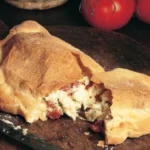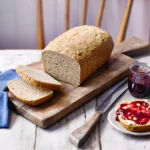Are you tired of the same old bread recipes? Looking to add a little flavor and excitement to your baking routine? Well, look no further than this mouthwatering pesto bread recipe.
It’s like a burst of sunshine on a cloudy day, infusing your bread with the vibrant flavors of basil, garlic, and Parmesan cheese. But that’s not all, there’s a secret ingredient that takes this recipe to a whole new level, leaving you craving for more.
Trust me, you won’t want to miss out on this one.
Contents
- 1 Key Takeaways
- 2 Ingredients
- 3 Making the Pesto
- 4 Preparing the Bread Dough
- 5 Adding the Pesto to the Dough
- 6 Shaping and Baking the Bread
- 7 Pesto Bread Recipe
- 8 Serving and Storing Tips
- 9 Nutrition facts
- 10 Frequently Asked Questions
- 10.1 Can I Use Store-Bought Pesto Instead of Making My Own?
- 10.2 How Long Does the Pesto Bread Dough Need to Rise?
- 10.3 Can I Freeze the Pesto Bread Dough for Later Use?
- 10.4 Can I Add Additional Ingredients, Like Cheese or Sun-Dried Tomatoes, to the Bread Dough?
- 10.5 Can I Use a Bread Machine to Make the Pesto Bread?
- 11 Conclusion
Key Takeaways
- Pesto can be made with various ingredients such as basil, pine nuts, garlic, and Parmesan cheese.
- To incorporate pesto into bread dough, spread it evenly over the risen dough and fold and knead to distribute it.
- When shaping and baking the bread, shape the dough into a rectangle, roll it tightly into a log, and bake until golden brown and hollow-sounding.
- To store leftover pesto bread, allow it to cool completely before storing it in an airtight container or tightly wrapped in plastic. To reheat, thaw the bread at room temperature and use a toaster or toaster oven for a quick reheat.
Ingredients
To make the delicious Pesto Bread, gather all the necessary ingredients in your kitchen. The star ingredient, of course, is pesto. Pesto comes in various forms, allowing you to experiment with different flavors and textures. Traditional pesto is made with fresh basil leaves, pine nuts, garlic, Parmesan cheese, and olive oil. However, you can also try variations like sun-dried tomato pesto, spinach pesto, or even arugula pesto for a peppery kick.
Once you have your preferred pesto, it’s important to store it properly to maintain its freshness. One tip is to transfer the pesto into an airtight container and cover the surface with a thin layer of olive oil. This creates a barrier that prevents the pesto from oxidizing and turning brown. Alternatively, you can freeze the pesto in ice cube trays for individual servings. Simply pop out a cube whenever you need some pesto and let it thaw.
Now that you have gathered all the ingredients and learned how to store your pesto, you’re ready to embark on the journey of making your own Pesto Bread. Get ready to experience the freedom of creating a mouth-watering masterpiece that will leave everyone begging for more.
Making the Pesto
Now that you have gathered all the necessary ingredients and learned how to properly store your pesto, it’s time to dive into the exciting process of making your very own flavorful pesto. Pesto is a versatile sauce that can be made in various ways, allowing you to explore different flavors and combinations.
Traditional pesto consists of fresh basil, pine nuts, garlic, Parmesan cheese, and olive oil. However, you can experiment with different variations of pesto recipes by substituting the basil with other herbs like cilantro or mint, and swapping the pine nuts for almonds or walnuts for a unique twist.
To make your pesto, start by placing the herbs, nuts, garlic, and cheese in a food processor. Pulse until everything is finely chopped. Then, slowly drizzle in the olive oil while the processor is running until the mixture becomes smooth and creamy. Remember to season with salt and pepper to taste.
Once you’ve made your pesto, the possibilities are endless! You can use it as a spread for sandwiches or wraps, toss it with pasta for a quick and delicious meal, or even use it as a marinade for grilled meats and vegetables. Get creative and explore different ways to incorporate pesto into your favorite dishes.
The vibrant flavors of the pesto will add a burst of freshness and depth to whatever you decide to make. Enjoy the freedom of experimenting and discovering new culinary delights with your homemade pesto.
Preparing the Bread Dough
Start by gathering all the ingredients you’ll need to prepare the bread dough. Here’s what you’ll need:
- 3 cups of all-purpose flour
- 1 tablespoon of sugar
- 1 teaspoon of salt
- 2¼ teaspoons of active dry yeast
- 1 cup of warm water
Now that you have everything ready, it’s time to start making the dough. In a large mixing bowl, combine the flour, sugar, salt, and yeast. Mix them together until they’re well combined.
Next, slowly add the warm water to the dry ingredients. Use a wooden spoon or your hands to mix everything together until a shaggy dough forms. Once the dough comes together, transfer it to a lightly floured surface.
Now comes the fun part – kneading the dough. Using the heel of your hand, push the dough away from you, then fold it back over itself. Repeat this motion for about 10 minutes, until the dough becomes smooth and elastic.
After kneading, place the dough in a greased bowl and cover it with a clean kitchen towel. Let it rise in a warm place for about 1 to 1.5 hours, or until it has doubled in size.
And there you have it – the bread dough is now ready for the next step in making your delicious pesto bread.
Adding the Pesto to the Dough
Enhance the flavor and texture of your bread by incorporating the vibrant and aromatic pesto into the dough. Adding pesto to your bread dough not only infuses it with delicious flavors but also gives it a beautiful green hue. The versatility of pesto allows for endless variations and flavor combinations, making it a perfect addition to your bread recipes.
Here are some tips for incorporating pesto into other bread recipes:
| Pesto Variation | Flavor Combination |
|---|---|
| Classic Basil Pesto | Tomato and Mozzarella |
| Sun-dried Tomato Pesto | Parmesan and Rosemary |
| Spinach and Walnut Pesto | Feta and Red Onion |
| Roasted Red Pepper Pesto | Goat Cheese and Thyme |
To incorporate pesto into your bread dough, simply follow these steps:
- Prepare your bread dough according to the recipe.
- Once the dough has risen, spread a generous amount of pesto evenly over the surface.
- Gently fold and knead the dough to distribute the pesto throughout.
- Allow the dough to rise again before shaping it into loaves or rolls.
- Bake as directed, and enjoy the delicious aroma and taste of pesto-infused bread.
Experiment with different pesto variations and flavor combinations to find your favorite. Whether you’re making a classic basil pesto or trying out something more adventurous, adding pesto to your bread dough is a surefire way to elevate your baking game.
Shaping and Baking the Bread
To achieve a beautifully shaped and perfectly baked loaf of pesto-infused bread, follow these simple steps:
- Shape the Dough: After the dough has risen, gently punch it down to release any air bubbles. Turn the dough out onto a lightly floured surface and shape it into a rectangle. Fold the top third down and the bottom third up, like folding a letter. Roll the dough tightly from one end to the other, creating a smooth and even log shape.
- Proof the Dough: Place the shaped dough into a greased loaf pan or onto a baking sheet lined with parchment paper. Cover it loosely with plastic wrap or a clean kitchen towel and let it rise for the final time. This will allow the dough to relax and rise slightly before baking.
- Preheat the Oven: While the dough is proofing, preheat your oven to the specified temperature in the recipe. It’s important to have a hot oven to give the bread a good initial rise and help it develop a crisp crust.
- Bake the Bread: Once the dough has finished proofing, remove the plastic wrap or towel and place the loaf pan or baking sheet into the preheated oven. Bake the bread for the specified time, until it’s golden brown and sounds hollow when tapped on the bottom.
- Troubleshooting Common Baking Issues: If your bread is browning too quickly, cover it loosely with aluminum foil to prevent it from burning. If the bread isn’t browning enough, increase the oven temperature slightly and bake for a few more minutes. If the bread isn’t rising properly, check the expiration date of your yeast and make sure it’s fresh. You can also try placing the dough in a warm place, such as near a preheated oven or on top of a warm stove, to encourage yeast activity.
Pesto Bread Recipe
Course: AppetizersCuisine: Italian-inspiredDifficulty: Moderate4
servings30
minutes40
minutes300
kcalPesto Bread is a delightful fusion of a classic bread recipe and the vibrant flavors of homemade pesto. This dish seamlessly combines the warmth of freshly baked bread with the aromatic essence of basil, garlic, and Parmesan found in pesto. The result is a savory and aromatic loaf that's perfect for sharing at gatherings or serving alongside your favorite Italian-inspired meals.
Ingredients
2 cups fresh basil leaves, packed
1/2 cup grated Parmesan cheese
1/2 cup pine nuts or walnuts
3 garlic cloves
1/2 cup extra-virgin olive oil
Salt and pepper to taste
Directions
- In a food processor, combine basil, Parmesan cheese, pine nuts or walnuts, and garlic cloves
- Pulse until finely chopped.
- With the processor running, slowly pour in the olive oil until the pesto reaches a smooth consistency.
- Season with salt and pepper to taste. Set aside.
- Bake in the preheated oven for 25-30 minutes or until the bread is golden brown.
- Remove from the oven and let it cool for a few minutes before slicing.
Serving and Storing Tips
For the best experience with your pesto bread, here are some serving and storing tips to ensure its freshness and flavor. Once your pesto bread is baked and cooled, you can enjoy it in various ways. Serve it as a side dish for soup or salad, or use it as a base for sandwiches or bruschetta. The possibilities are endless!
To store your pesto bread and keep it fresh, it’s important to follow a few guidelines. Firstly, allow the bread to cool completely before storing it. This helps to prevent moisture buildup and keeps the bread from becoming soggy. Secondly, store the bread in an airtight container or tightly wrapped in plastic wrap. This will help to retain its moisture and prevent it from drying out.
If you have leftover pesto bread and want to enjoy it later, there are a couple of options. You can freeze the bread to extend its shelf life. Simply slice the bread, wrap each slice in plastic wrap, and place them in a freezer-safe bag. When you’re ready to eat the bread, thaw it at room temperature or pop it in the toaster for a quick reheat.
Here’s a table summarizing the serving and storing tips for your convenience:
| Tips for freezing pesto bread | How to reheat leftover pesto bread |
|---|---|
| Slice the bread | Thaw at room temperature |
| Wrap each slice in plastic wrap | Pop in the toaster for a quick reheat |
| Place slices in a freezer-safe bag |
Nutrition facts
- Calories: 200-250 kcal
- Total Fat: 10-15g
- Saturated Fat: 2-4g
- Trans Fat: 0g
- Cholesterol: 0-5mg
- Sodium: 200-300mg
- Total Carbohydrates: 22-30g
- Dietary Fiber: 1-2g
- Sugars: 1-2g
- Protein: 5-7g
Frequently Asked Questions
Can I Use Store-Bought Pesto Instead of Making My Own?
Yes, you can definitely use store-bought pesto instead of making your own. It’s a convenient option that saves time and effort. However, if you prefer the freshness and unique flavors of homemade pesto, go for it! The choice is yours.
How Long Does the Pesto Bread Dough Need to Rise?
To achieve the perfect rise in your pesto bread dough, it’s important to let it rest and rise for the right amount of time. Follow the recipe’s instructions for the best results.
Can I Freeze the Pesto Bread Dough for Later Use?
Yes, you can freeze the pesto bread dough for later use. Freezing the dough is a convenient way to store it, giving you the freedom to bake fresh, delicious pesto bread whenever you crave it.
Can I Add Additional Ingredients, Like Cheese or Sun-Dried Tomatoes, to the Bread Dough?
Yes, you can definitely add additional ingredients like cheese or sun-dried tomatoes to the bread dough. This allows for flavor variations in the pesto bread, giving you the freedom to create a more personalized and delicious loaf.
Can I Use a Bread Machine to Make the Pesto Bread?
Sure, you can totally use a bread machine to make the pesto bread! It’s a convenient alternative method. Just imagine the aroma of freshly baked, flavorful bread filling your kitchen. Delicious!
Conclusion
In just a few simple steps, you can create a mouthwatering pesto bread that’s sure to impress. With the aromatic flavors of freshly made pesto and the warm, crusty texture of homemade bread, this recipe is a winner.
Whether you serve it as a delicious side dish or as the star of the meal, this pesto bread is guaranteed to satisfy your taste buds and leave you craving for more.
So why wait? Get baking and enjoy the delightful flavors of this irresistible treat!









